light CITROEN RELAY 2015 Handbook (in English)
[x] Cancel search | Manufacturer: CITROEN, Model Year: 2015, Model line: RELAY, Model: CITROEN RELAY 2015Pages: 248, PDF Size: 8.86 MB
Page 4 of 248
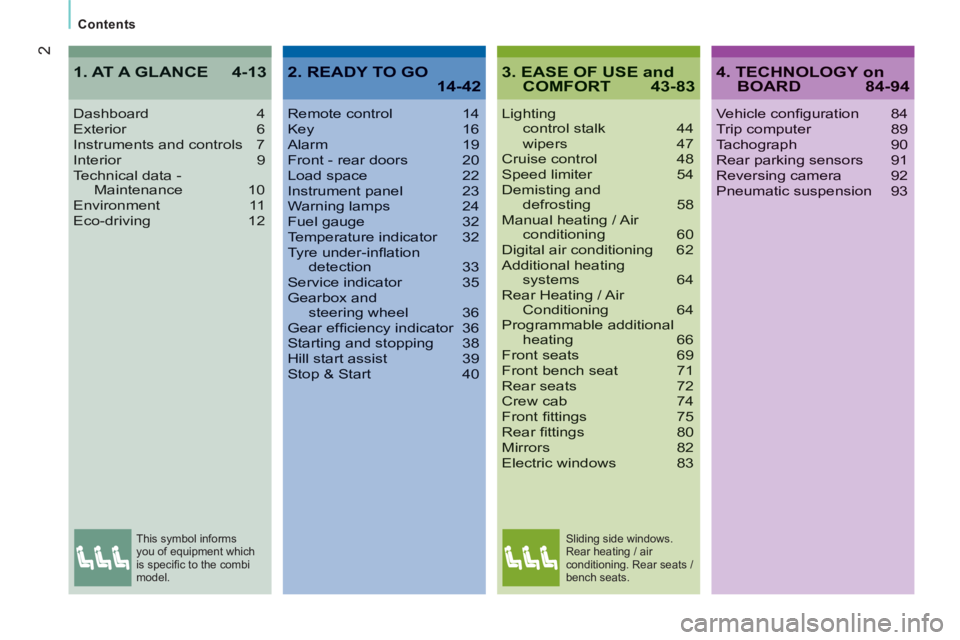
2
Contents
3. EASE OF USE and COMFORT 43-83
Lighting control stalk 44 wipers 47Cruise control 48Speed limiter 54Demisting and defrosting 58Manual heating / Air conditioning 60Digital air conditioning 62Additional heating systems 64Rear Heating / Air Conditioning 64Programmable additional heating 66Front seats 69Front bench seat 71Rear seats 72Crew cab 74Front fi ttings 75Rear fi ttings 80Mirrors 82Electric windows 83
Dashboard 4Exterior 6Instruments and controls 7Interior 9Technical data - Maintenance 10Environment 11Eco-driving 12
1. AT A GLANCE 4-134. TECHNOLOGY on BOARD 84-94
Vehicle confi guration 84Trip computer 89Tachograph 90Rear parking sensors 91Reversing camera 92Pneumatic suspension 93
2. READY TO GO 14-42
Remote control 14Key 16Alarm 19Front - rear doors 20Load space 22Instrument panel 23Warning lamps 24Fuel gauge 32Temperature indicator 32Tyre under-infl ation detection 33Service indicator 35Gearbox and steering wheel 36Gear effi ciency indicator 36Starting and stopping 38Hill start assist 39Stop & Start 40
This symbol informs
you of equipment which
is specifi c to the combi
model. Sliding side windows.
Rear heating / air
conditioning. Rear seats /
bench seats.
Page 6 of 248
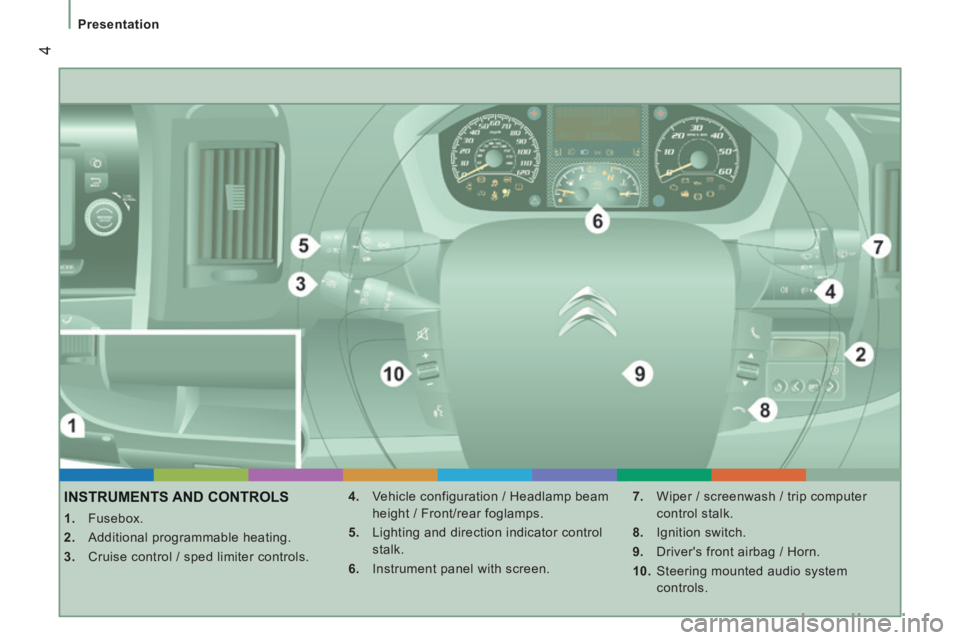
4
Presentation
INSTRUMENTS AND CONTROLS
1. Fusebox.
2. Additional programmable heating.
3. Cruise control / sped limiter controls. 4. Vehicle configuration / Headlamp beam
height / Front/rear foglamps.
5. Lighting and direction indicator control stalk.
6. Instrument panel with screen. 7. Wiper / screenwash / trip computer
control stalk.
8. Ignition switch.
9. Driver's front airbag / Horn.
10. Steering mounted audio system controls.
Page 7 of 248
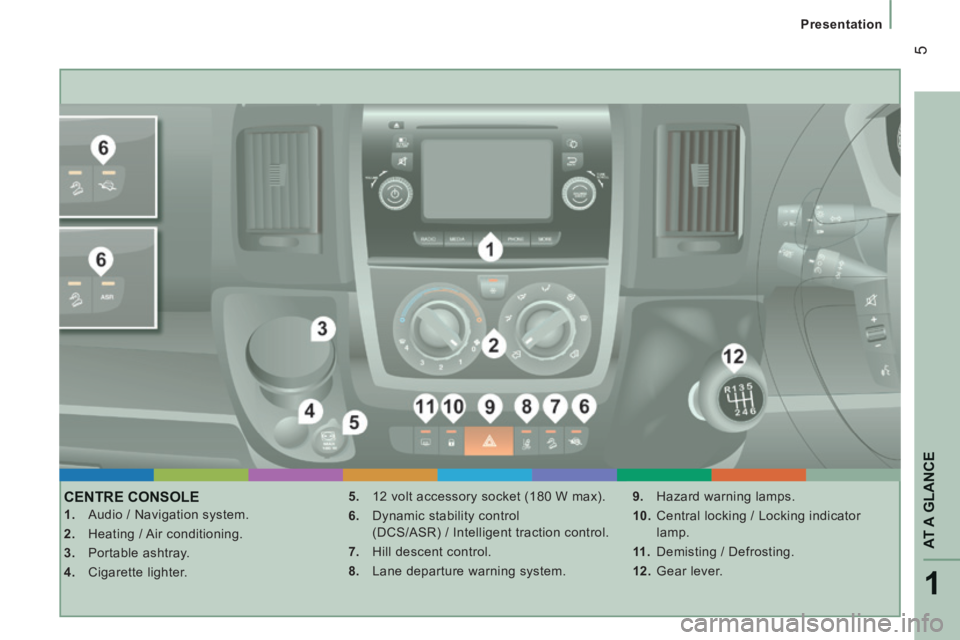
1
AT A GLANCE
5
Presentation
CENTRE CONSOLE
1. Audio / Navigation system.
2. Heating / Air conditioning.
3. Portable ashtray.
4. Cigarette lighter. 5. 12 volt accessory socket (180 W max).
6. Dynamic stability control
(DCS/ASR) / Intelligent traction control.
7. Hill descent control.
8. Lane departure warning system. 9. Hazard warning lamps.
10. Central locking / Locking indicator
lamp.
11 . Demisting / Defrosting.
12. Gear lever.
Page 9 of 248
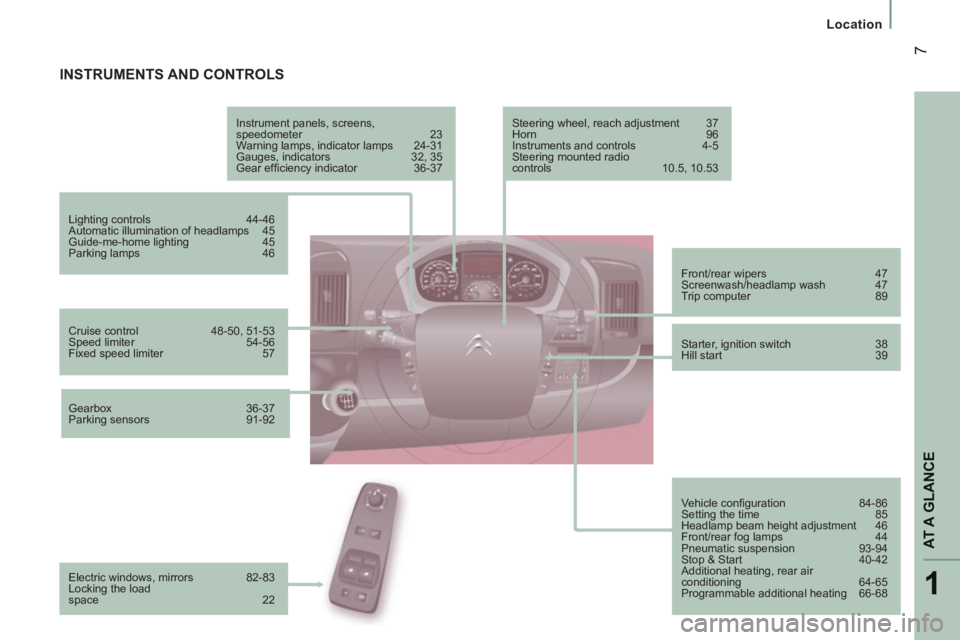
1
AT A GLANCE
7
Location
INSTRUMENTS AND CONTROLS
Instrument panels, screens,
speedometer 23
Warning lamps, indicator lamps 24-31
Gauges, indicators 32, 35
Gear effi ciency indicator 36-37
Lighting controls 44-46
Automatic illumination of headlamps 45
Guide-me-home lighting 45
Parking lamps 46
Vehicle confi guration 84-86
Setting the time 85
Headlamp beam height adjustment 46
Front/rear fog lamps 44
Pneumatic suspension 93-94
Stop & Start 40-42
Additional heating, rear air
conditioning 64-65 Programmable additional heating 66-68 Front/rear wipers 47
Screenwash/headlamp wash 47
Trip computer 89
Starter, ignition switch 38
Hill start 39
Cruise control
48-50, 51-53
Speed limiter 54-56
Fixed speed limiter 57 Steering wheel, reach adjustment 37
Horn
96
Instruments and controls 4-5
Steering mounted radio
controls 10.5, 10.53
Electric windows, mirrors 82-83
Locking the load
space 22
Gearbox
36-37
Parking sensors 91-92
Page 10 of 248

8
Location
Lane departure warning system 101
Hill descent control 100
ASR, DSC 98-99
Intelligent Traction Control 99-100
Vehicle confi guration
87-88
Setting the time 88
Reversing camera 92
Touch screen audio system 10.1-10.50
Audio system 10.51-10.68
Tachograph
90
Cab fi ttings 75-80
● cigarette lighter,
● glove box - cooled,
● overhead storage,
● portable ashtray,
● courtesy lamps,
● 12 volt socket,
● writing table,
● storage compartments.
Demisting-defrosting
58
Central locking 22
Locking indicator lamp 22
Hazard warning lamps 95 Ventilation, heating, A/C 59-61, 62-63
● manual air conditioning,
● mono-zone digital air
conditioning,
● air recirculation.
Opening the bonnet 122
Dashboard fuses 134-136
Page 12 of 248
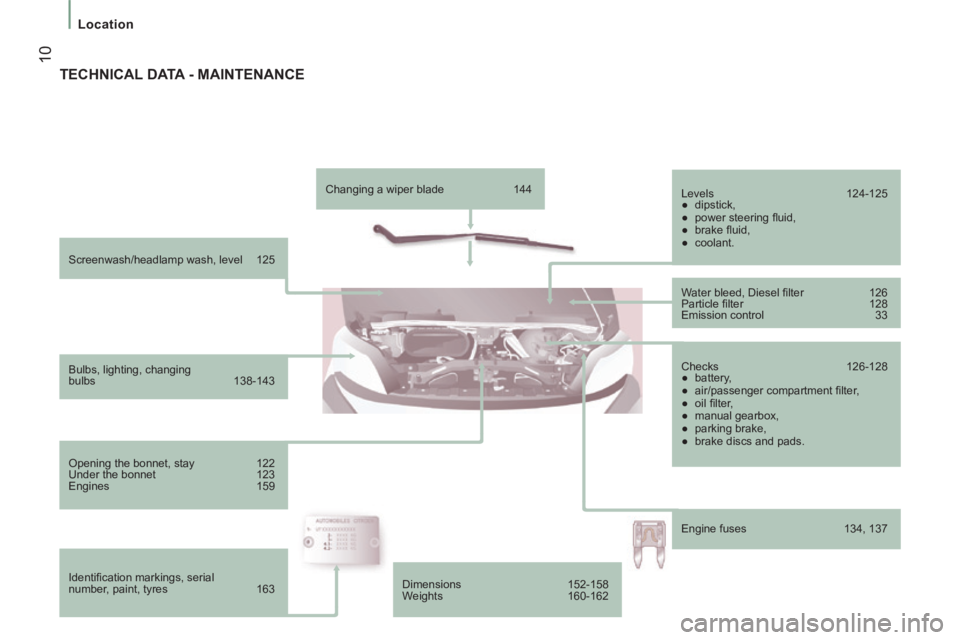
10
Location
Screenwash/headlamp wash, level 125
Bulbs, lighting, changing
bulbs 138-143
Opening the bonnet, stay 122
Under the bonnet 123
Engines 159
Identifi cation markings, serial
number, paint, tyres 163 Changing a wiper blade
144
Levels 124-125
● dipstick,
● power steering fl uid,
● brake fl uid,
● coolant.
Water bleed, Diesel fi lter 126
Particle fi lter 128
Emission control 33
Checks 126-128
● battery,
● air/passenger compartment fi lter,
● oil fi lter,
● manual gearbox,
● parking brake,
● brake discs and pads.
Engine fuses 134, 137
TECHNICAL DATA - MAINTENANCE
Dimensions 152-158
Weights 160-162
Page 14 of 248
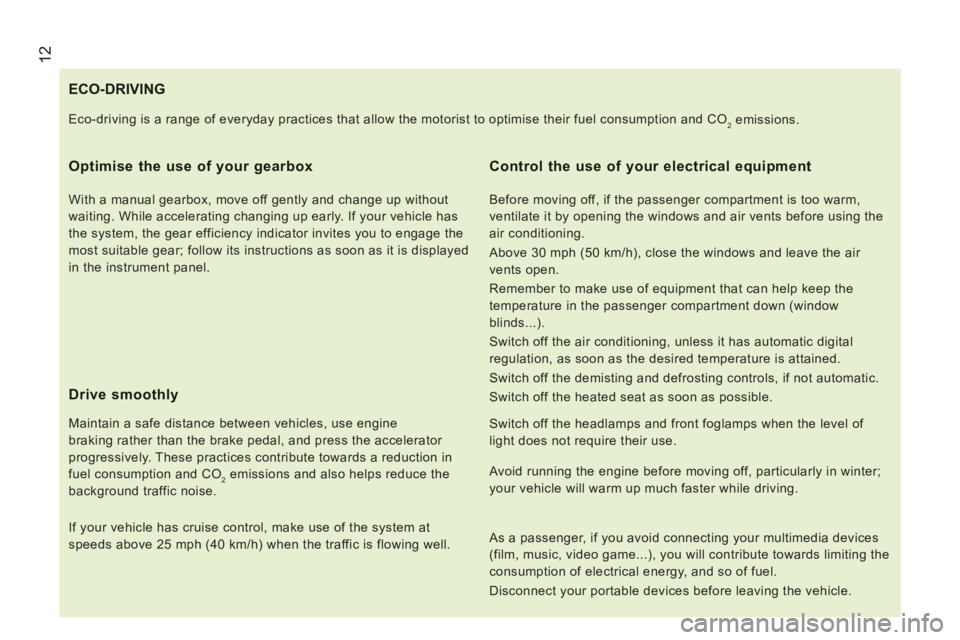
12
ECO-DRIVING
Optimise the use of your gearbox
With a manual gearbox, move off gently and change up without
waiting. While accelerating changing up early. If your vehicle has
the system, the gear efficiency indicator invites you to engage the
most suitable gear; follow its instructions as soon as it is displayed
in the instrument panel.
Drive smoothly
Maintain a safe distance between vehicles, use engine
braking rather than the brake pedal, and press the accelerator
progressively. These practices contribute towards a reduction in
fuel consumption and CO
2 emissions and also helps reduce the
background traffic noise.
If your vehicle has cruise control, make use of the system at
speeds above 25 mph (40 km/h) when the traffic is flowing well.
Control the use of your electrical equipment
Before moving off, if the passenger compartment is too warm,
ventilate it by opening the windows and air vents before using the
air conditioning.
Above 30 mph (50 km/h), close the windows and leave the air
vents open.
Remember to make use of equipment that can help keep the
temperature in the passenger compartment down (window
blinds...).
Switch off the air conditioning, unless it has automatic digital
regulation, as soon as the desired temperature is attained.
Switch off the demisting and defrosting controls, if not automatic.
Switch off the heated seat as soon as possible.
Switch off the headlamps and front foglamps when the level of
light does not require their use.
Eco-driving is a range of everyday practices that allow the motorist to \
optimise their fuel consumption and CO
2 emissions.
Avoid running the engine before moving off, particularly in winter;
your vehicle will warm up much faster while driving.
As a passenger, if you avoid connecting your multimedia devices
(film, music, video game...), you will contribute towards limiting the\
consumption of electrical energy, and so of fuel.
Disconnect your portable devices before leaving the vehicle.
Page 31 of 248
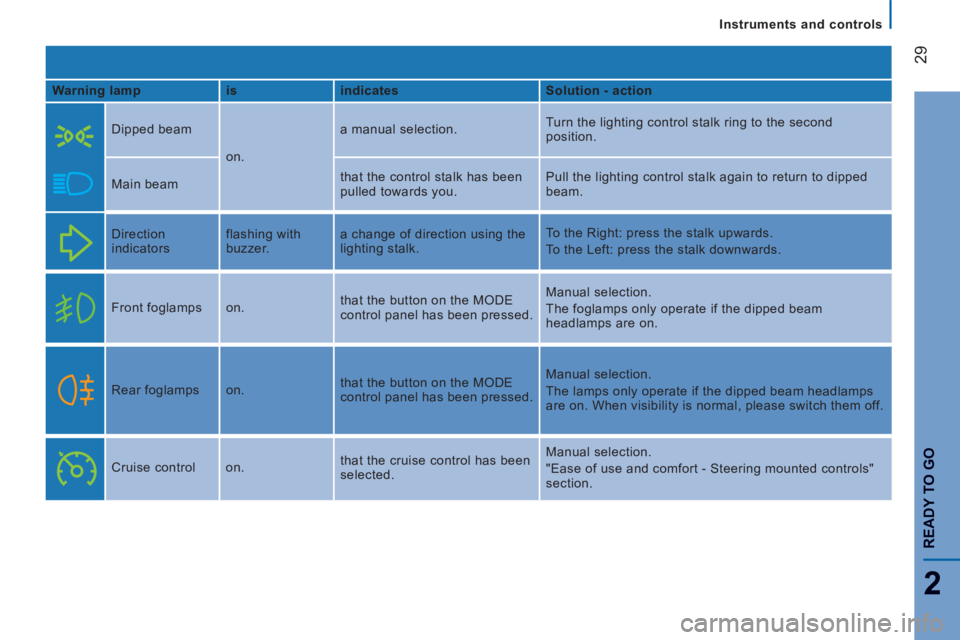
29
2
READY TO GO
Instruments and controls
Warning lamp is indicates Solution - action
Dipped beam
on. a manual selection.
Turn the lighting control stalk ring to the second
position.
Main beam that the control stalk has been
pulled towards you. Pull the lighting control stalk again to return to dipped
beam.
Direction
indicators flashing with
buzzer. a change of direction using the
lighting stalk. To the Right: press the stalk upwards.
To the Left: press the stalk downwards.
Front foglamps on. that the button on the MODE
control panel has been pressed. Manual selection.
The foglamps only operate if the dipped beam
headlamps are on.
Rear foglamps on. that the button on the MODE
control panel has been pressed. Manual selection.
The lamps only operate if the dipped beam headlamps
are on. When visibility is normal, please switch them off.
Cruise control on. that the cruise control has been
selected. Manual selection.
"Ease of use and comfort - Steering mounted controls"
section.
Page 38 of 248

36
Gearbox and steering wheel
To change gear easily, always depress the
clutch pedal fully.
To prevent the mat from becoming caught
under the pedal:
- ensure that the mat is positioned correctly,
- never fit one mat on top of another.
Avoid leaving your hand on the gear knob as
the force exerted, even if slight, may wear
the internal components of the gearbox
over time.
MANUAL GEARBOX
Reverse gear
Raise the collar under the gear knob to
engage reverse gear. Never engage reverse gear before the
vehicle is completely stationary.
The lever should be moved slowly to reduce
the noise on engaging reverse gear.
Your reversing manoeuvre is indicated by an
audible exterior warning.
If your vehicle is fitted with parking
sensors, the system comes into
operation when reverse gear is engaged and
an audible signal is heard.
Refer to the "Technology on board -
Parking sensors" section.
GEAR EFFICIENCY INDICATOR
This system allows fuel consumption to be
reduced by suggesting when to change up.
The gear engagement recommendations
should not be considered to be compulsory.
This because the configuration of the
road, the traffic density and safety remain
determining factors when choosing the
best gear. Therefore, the driver remains
responsible for deciding whether or not to
follow the advice given by the system.
The system never recommends engaging
first gear or reverse, or changing down.
Page 42 of 248

40
Starting and stopping
The Stop & Start system puts the engine
temporarily into standby - STOP mode -
during stops in the traffic (red lights, traffic
jams, or other...). The engine restarts
automatically - START mode - as soon as
you want to move off. The restart takes
place instantly, quickly and silently.
Perfect for urban use, the Stop & Start
system reduces fuel consumption and
exhaust emissions and offers the comfort
of complete silence when stationary.
STOP & START
Operation
Going into engine STOP mode
With the vehicle stationary, put the gear
lever into neutral, then release the clutch
pedal. - The "S" warning lamp comes on in the instrument
panel and the engine goes
into standby. Automatic stopping of the engine is
only possible after the vehicle has
exceed a speed of about 6 mph (10 km/h),
to avoid repeated stopping of the engine
when driving slowly.
Never leave your vehicle with out first
turning off the ignition with the key.
Never refuel with the engine
in STOP mode; you must switch
off the ignition with the key. Special cases: STOP mode
unavailable
The STOP mode is not invoked when:
- the system is initialising,
- the driver's door is open,
- the driver's seat belt is not fastened,
- the air conditioning is running,
- the heated rear screen is on,
- the windscreen wiper is on fast wipe,
- reverse gear is engaged, for a parking
manoeuvre,
- some special conditions (battery charge, engine temperature, particle
filter regeneration, braking assistance,
ambient temperature...) where the
engine is needed to assure control of
a system.
The "S" warning lamp flashes for
a few seconds, then goes off.
This operation is perfectly normal.